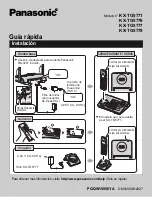
121
Appendix
Operating range
This cordless telephone operates with the maximum power allowed by the Federal
Communications Commission (FCC). Even so, this handset and telephone base can
communicate over only a certain distance - which can vary with the locations of the telephone
base and handset, the weather, and the layout of your home or office.
When the handset is out of range, the handset displays
Out of range OR No power at base.
If there is a call while the handset is out of range, it might not ring, or if it does ring, the call might
not connect well when you press
/HOME/
FLASH
. Move closer to the telephone base, then press
/HOME/
FLASH
to answer the call.
If the handset moves out of range during a telephone conversation, there might be interference.
To improve reception, move closer to the telephone base.
Maintenance
Taking care of your telephone
Your cordless telephone contains sophisticated electronic parts, so it must be treated with care.
Avoid rough treatment
Place the handset down gently. Save the original packing materials to protect your telephone if
you ever need to ship it.
Avoid water
Your telephone can be damaged if it gets wet. Do not use the handset outdoors in the rain, or
handle it with wet hands. Do not install the telephone base near a sink, bathtub or shower.
Electrical storms
Electrical storms can sometimes cause power surges harmful to electronic equipment. For your
own safety, take caution when using electrical appliances during storms.
Cleaning your telephone
Your telephone has a durable plastic casing that should retain its luster for many years. Clean
it only with a soft cloth slightly dampened with water or mild soap. Do not use excess water or
cleaning solvents of any kind.
Battery
CAUTION: Use Only Supplied Battery.
Do not dispose of the battery in a fire. Check with local waste management codes for special
disposal instructions.
Do not open or mutilate the battery. Released electrolyte is corrosive and may cause burns or
injury to the eyes or skin. The electrolyte may be toxic if swallowed.
Exercise care in handling batteries in order not to create a short circuit with conductive materials.
Charge the battery provided with this product only in accordance with the instructions and
limitations specified in this manual.
Precautions for users of implanted cardiac pacemakers
Cardiac pacemakers (applies only to digital cordless telephones):
Wireless Technology Research, LLC (WTR), an independent research entity, led a
multidisciplinary evaluation of the interference between portable wireless telephones and
implanted cardiac pacemakers. Supported by the U.S. Food and Drug Administration, WTR
recommends to physicians that:
Pacemaker patients:
Should keep wireless telephones at least six inches from the pacemaker.
Should NOT place wireless telephones directly over the pacemaker, such as in a breast pocket,
when it is turned ON.
Should use the wireless telephone at the ear opposite the pacemaker.
WTR’s evaluation did not identify any risk to bystanders with pacemakers from other persons
using wireless telephones.
•
•
•
•
•
•
•
•















































